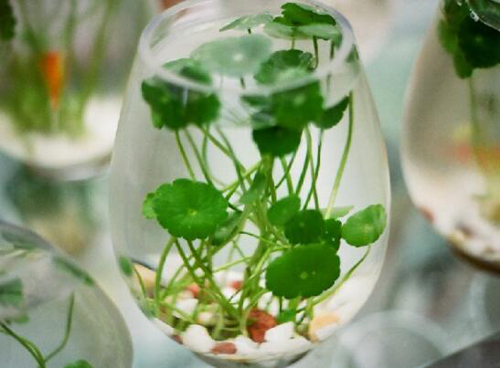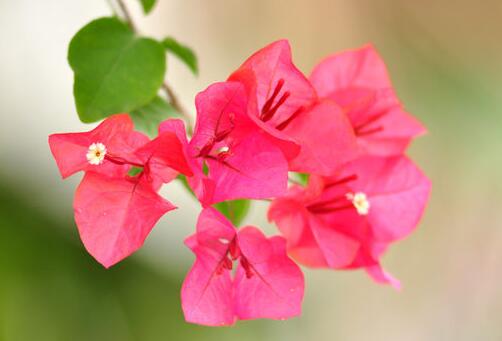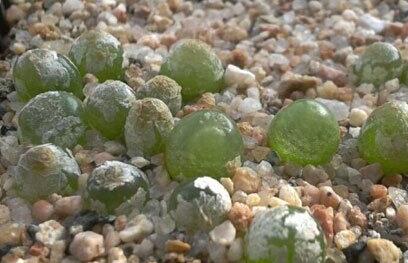What are the matters needing attention in how to raise copper grass in water?
Rabdosia angustifolia is a kind of plant with very tenacious vitality. even if its leaves are carelessly bowed by the sun when cultivated in soil, it may stand up overnight even if it is watered overnight, and it is very suitable for hydroponics. Let's take a look at how to grow it in water.

How to raise copper grass in water:
1. We need to treat the roots of Codonopsis lanceolata, because it is continuous, so in order to facilitate the arrangement, we can cut it into an independent root or 1-3 roots, depending on the actual situation.
2. If the previous grass was planted in soil, you need to rinse the roots clean and be careful not to break the leaves or stems.
3, the following is the display, the flower friends will clean up the copper grass reasonably placed in the vessel, and then pour into the water.
Ps: it's necessary to say that sometimes copper grass can't be fixed in hydroponic utensils. Flower friends can put some stones or sand to fix it.
4. After the copper grass is placed, slow the seedlings in an astigmatic environment. If there are rotten leaves and so on, you can lose them. # p# subtitle # e #
Points for attention in hydroponic culture of Rabdosia angustifolia
1, hydroponic copper grass had better not long-term direct sunlight, so it is easy to grow green water moss in the vessel.
2. The phototaxis of Codonopsis lanceolata is very strong, pay attention to the orientation of the container, otherwise the leaves are easy to grow askew to one side, affecting beauty.
3. Rabdosia angustifolia propagates very fast, because the hydroponic space is limited, so in order to be beautiful, the extra leaves should be cleaned up in time.
4. The flowers of Codonopsis lanceolata are not good-looking and consume nutrients, so if there is no need, cut off the stems in time when you find that there is a blossom.
How to raise Rabdosia angustifolia in Water
Copper grass, also known as water money, likes humid environmental conditions, so how to raise it in water? Next, let's tell you the method of hydroponic culture of Tongqian grass.
How to raise Tongqian grass in water
1. Water quality: Codonopsis lanceolata does not have high requirements for hydroponic quality, as long as it does not cause smelly insects, it can be hydroponically cultured directly with ordinary tap water. Change the water about 3-4 days in summer, half of the basin at a time, and 1/3 at a time in winter.
2. Fertilization: Rabdosia mandshurica can produce the necessary nutrients for growth through its own photosynthesis, so it can fertilize less. If you need to apply fertilizer, you can use ordinary chemical fertilizer water to dissolve in the water basin, let it absorb itself, but pay attention to the amount is not too strong, a small amount can be.
3.Illumination: Codonopsis lanceolata is extremely fond of sunlight when it grows, so it is best to put the basin outside or by the window where there is plenty of light. If cultivated indoors, the sun exposure time should not be less than 4-5 hours per day. In addition, ultraviolet lights or bright fluorescent lamps can also be used instead of sunlight.
4. Insect pests: copper grass generally does not attract insect pests, but molluscs such as water snails may gnaw on grass roots and buds. If such insects are found in the water, they should be removed by hand to prevent them from multiplying in large numbers.
5. Temperature: Rabdosia angustifolia is suitable for production in most hot and humid areas of the south, especially in summer. Its normal growth temperature is between 10 and 26 degrees Celsius. Overheating or overcooling will inhibit the growth of Rabdosia angustifolia.
6. Reproduction: Rabdosia angustifolia is generally propagated by individual plants, which is disconnected in the place where the stolon takes root with scissors in summer, and the former plant can be transferred to other water basins to reproduce. In addition, in summer, Rabdosia przewalskii will produce small flowers, and then the seeds can be used to propagate new plants.
The method of hydroponic culture of Rabdosia angustifolia
1. There is no need to change the water very frequently. Under the premise that there is enough water in the basin, you can change it once a week. If you can change water more frequently in summer, it is mainly to prevent mosquitoes from laying eggs in it.
2. Keep enough light and receive more than 4 hours of sunlight every day before the grass can grow luxuriantly and verdant. Rabdosia angustifolia is particularly fond of the sun and can grow rapidly even if it does not release fertilizer in sufficient sunlight; on the other hand, if it is not bright enough or kept in a dark room for a long time, its leaves will easily turn yellow and wither.
3. There is no need to pay much attention to fertilization. If you have goldfish at home, you can pour the water from the goldfish into the basin, which can make the goldfish grow better.
4. In the south, if you grow well in the temperature range of 16-24 ℃, you can survive naturally. However, too high or too low temperature will inhibit the growth of Rabdosia angustifolia, and bugs are more likely to sprout in the water at high temperatures.
5. When the water raises Codonopsis lanceolata, the yellowing leaves will rot in the water and spoil the water quality, so we should check the water tank regularly and find that the moldy leaves should be pulled out as soon as possible.
6. The vigorous growth of Rabdosia angustifolia can spread all over the water basin in a month, so we should prune and branch it properly and transplant the overdense Rabdosia angustifolia to other water basins, so as not to block the light of the young leaves and affect the normal metabolism of plants.
Matters needing attention in raising copper grass in water:
1. Tongqian grass is suitable for extensive cultivation, as long as it is given enough sunshine and water, it can grow very fast.
2. If there is no sunshine indoors, lights can be used instead.
3. Water needs to precipitate tap water for two hours, or use it every other day.
How to hydroponically cultivate Rabdosia angustifolia
The method of hydroponic cultivation of Tongqian grass is relatively a way loved by lazy people. The following is a detailed introduction of the hydroponic culture method of Rabdosia angustifolia. And matters needing attention in breeding.
How to cultivate Rabdosia angustifolia in water
1. Tongqiancao's requirements for water quality: just choose ordinary tap water. Change the water frequently. Change the water every 3-4 days in summer, and the water level is half of the bottle. Change the water once a week in winter. The transpiration of leaves is less in winter, so it is possible to change the pot at a time of 1 stroke to 3.
two。 The requirement of light: this kind of plant prefers light. I usually put the copper grass where the sun can shine, such as the windowsill. The sunshine can last longer in summer. 4-5 hours is a must. For example, if there is little light in winter, you can use ultraviolet lamp or fluorescent lamp instead of sunlight.
3. The temperature requirements of Codonopsis grossedentata: the editor is from the south, and it is easy to cultivate it by hydroponics. The climate in the south is very suitable for raising coppergrass. It is appropriate to keep the normal temperature at 10-26 degrees. Too hot or too cold is not suitable for the growth of Codonopsis pilosula.
4. How to prevent insect pests: the natural enemy of Rabdosia angustifolia is the water snail, which eats its roots and buds. If you see this kind of bug in the water, you must show no mercy. Breeding in large numbers can kill your coin grass.
5. Fertilization of Rabdosia angustifolia: personally, it is not recommended to fertilize it, because its own photosynthesis produces enough nutrients. Of course, you want to make it more luxuriant, you can apply the right amount of fertilizer, you can use ordinary chemical fertilizer to dissolve it in the basin and let it absorb itself, but be careful not to be too thick, just a small amount.
6. Propagation method of Rabdosia angustifolia: Rabdosia angustifolia is generally propagated by individual plants, which is disconnected in the place where the stolon takes root with scissors in summer, and the former plant can be transplanted to other water basins to reproduce. In addition, in summer, Rabdosia przewalskii will produce small flowers, and then the seeds can also be used to propagate new plants.
Matters needing attention in the Culture of Rabdosia angustifolia
1. Grasp the soil and water and sunshine: Tongqian grass leaves round wavy edge, long stem, summer and autumn open a small yellow-green flowers, land and water can be farmed. Like warm and humid, it is better to cultivate in half-day sunshine or shade, avoid direct sunlight, regardless of cultivated soil, and it is better to cultivate soil with soft and good drainage. Propagation can be done by ramet or cuttage, which is easy to cultivate, keep the cultivated soil moist, and root in about 1-2 weeks. Because the plant is moisture-tolerant and watery, it is also suitable for cultivation in water basin and pool. If aquaculture, be sure to change the water every week and add a special nutrient solution for foliage plants.
two。 Choose good drainage cultivation soil: copper grass does not need a large pot, can also be planted in a larger bowl, daffodils pot can also be used to raise daffodils, soil with general vegetable garden soil, appropriate amount mixed with some river sand, which add a small amount of organic fertilizer as base fertilizer. Money can be planted flat when the money is planted, it is better to cover the rhizome slightly and not to be too deep. Then leave it in the semi-shade for a week and wait for the new leaves to grow and see the sun again.
3. Grasp the temperature: Tongqian grass is afraid of the cold. If you put it outside in winter, you can pour out all the water. If you put it in a place facing south to the sun and leeward, you can survive the winter safely, but the leaves will die, and the underground roots will sprout again next spring. If there is no heating in the cold areas of the north, you can make a cover with a basin, pour out the water and keep it moist. As long as the room temperature is not lower than zero, it will continue to grow in the coming year.
- Prev

Six reasons why triangular plum does not blossom and its solutions
Triangular plums raised by flower friends do not blossom, or the flowers are very rare, so there is an urgent need to understand the reasons why triangular plum does not blossom. To put it simply, the failure of triangular plum to blossom is mostly due to lack of light, inadequate pruning, too dense branches and leaves, and insufficient soil and fertilizer. So if you want the plum blossom to blossom, you need to start from these places.
- Next

Meat cone light bulb how to maintain the best when it blossoms for several years
The meat cone light bulb is a plant of the genus Amygdalaceae. The surface of the plant is bright green and translucent, and it will blossom as long as the environment is right. How long does the meat cone light bulb bloom? the dormant period from May to September is the dormant period of the meat cone flower. After the dormancy period, the flower begins to grow and then blossoms, almost at the end of September and the beginning of October.
Related
- Fuxing push coffee new agricultural production and marketing class: lack of small-scale processing plants
- Jujube rice field leisure farm deep ploughing Yilan for five years to create a space for organic food and play
- Nongyu Farm-A trial of organic papaya for brave women with advanced technology
- Four points for attention in the prevention and control of diseases and insect pests of edible fungi
- How to add nutrient solution to Edible Fungi
- Is there any good way to control edible fungus mites?
- Open Inoculation Technology of Edible Fungi
- Is there any clever way to use fertilizer for edible fungus in winter?
- What agents are used to kill the pathogens of edible fungi in the mushroom shed?
- Rapid drying of Edible Fungi

